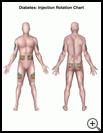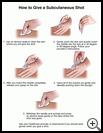
Diabetes Mellitus
What is diabetes mellitus?
Having diabetes means that there is too much sugar (glucose) in your blood. When you eat food, your body breaks down much of the food into glucose. Your blood carries the glucose to the cells of your body. An organ in your upper belly called the pancreas makes and releases a hormone called insulin when it detects glucose. Your body uses insulin to help move the glucose from the bloodstream into the cells for energy. When your body does not make enough insulin or has trouble using insulin, glucose cannot get into your cells. The glucose level in your blood goes up. Too much glucose in your blood (also called hyperglycemia or high blood sugar) can cause many problems.
There are 3 common types of diabetes: type 1, type 2, and gestational. There is also a related condition called prediabetes.
Type 1 diabetes is when your body makes no insulin. This is because the cells in the pancreas that make insulin are destroyed. The cause is not yet understood. Type 1 diabetes usually starts in childhood or young adulthood and requires that you take insulin the rest of your life.
Type 2 diabetes is when your body does not have enough insulin or has trouble using the insulin it makes. You are at higher risk for type 2 diabetes if you are African American, Latino, Native American, or Asian American, have a family history of diabetes, get little physical activity, are overweight, or eat a high-calorie diet.
Gestational diabetes is when a woman has high blood glucose levels during pregnancy. Diagnosis and treatment is very important. The mother can have problems from high blood glucose, such as high blood pressure. The baby can have problems, such as being born too early.
Prediabetes is a term used for people whose blood glucose level is above normal but not yet high enough to be called diabetes. People who have prediabetes are at high risk of getting diabetes. These people need to lower their risk by eating healthy and increasing their activity.
All of these types of diabetes, and prediabetes, have one thing in common, which is blood glucose levels that are too high if not treated.
What can I expect in the hospital?
You may need to stay in the hospital because:
- Your blood glucose is either very high or very low
- Your blood glucose is too high or too low because of other medical conditions that you have or medicines that you are taking
- You have other serious medical conditions caused by your diabetes
Several things may be done while you are in the hospital to monitor, test, and treat your condition. They include:
Monitoring
- You will be checked often by the hospital staff.
- Your blood glucose will be checked regularly. This may be done as often as every hour.
- A heart (cardiac) monitor may be used to keep track of your heartbeat.
- Your blood oxygen level may be monitored by a sensor that is attached to your finger or earlobe.
- Your fluid intake will be monitored closely by keeping track of everything you eat and drink and any IV fluids you receive.
- You may have a small tube (catheter) placed into your bladder to drain and measure urine.
Testing
Testing may include:
- Blood tests (Hemoglobin A1C) to check your average blood glucose over the past 3 months. Hemoglobin A1C is also known as HbA1C and A1C.
- Blood or urine tests to check for infections
- Blood tests to check to see if your body is making insulin
- Blood, urine, or other tests to monitor how well your organs are functioning
- Arterial blood gas (ABG), which is a blood test to measure the levels of oxygen and carbon dioxide in your blood. It also measures the balance of acids and bases in your blood (called the pH)
- X-rays, which use energy called radiation to make of pictures of your bones, tissues, and organs to check for infection
Treatment
The treatment for diabetes mellitus depends on the type of diabetes that you have and how well your blood glucose is controlled with treatment. The goal is for you to keep your blood glucose level in a normal range.
- You will have a small tube (IV catheter) inserted into a vein in your hand or arm. This will allow medicine to be given directly into your blood and to give you fluids, if needed.
- Your provider may prescribe medicines to:
- Control your blood glucose
- Treat other medical problems that may have been caused by or made worse by diabetes
- Treat pain
- Treat or prevent an infection
- Treat or prevent side effects, such as nausea or constipation, from other treatments
- Your provider may recommend other types of therapy to help relieve pain, other symptoms, or side effects of treatment.
- Your healthcare provider will recommend how much and what types of food you should eat each day. Your provider may refer you to a dietitian to help you learn about diet planning and meal management when you go home.
What can I do to help?
- You will need to tell your healthcare team if you have new or worsening:
- Increased urination or trouble emptying your bladder
- Increased thirst and dry mouth
- Increased appetite or loss of appetite
- Fast or irregular heartbeat
- Fruity odor to breath
- Change in vision, such as double vision, blurred vision, or trouble seeing out of one or both eyes
- Floaters, which are black spots or cobweb-like shapes in your vision
- Numbness in your feet or hands
- Redness, bumps, blisters, or sores on your skin
- Infection that does not go away or frequent infection
- Ask questions about any medicine, treatment, or information that you do not understand.
How long will I be in the hospital?
How long you stay in the hospital depends on many things, such as your general health, why you are in the hospital, and the treatment you need. Talk with your provider about how long your stay may be.
Last modified: 2016-02-24
Last reviewed: 2016-02-12



